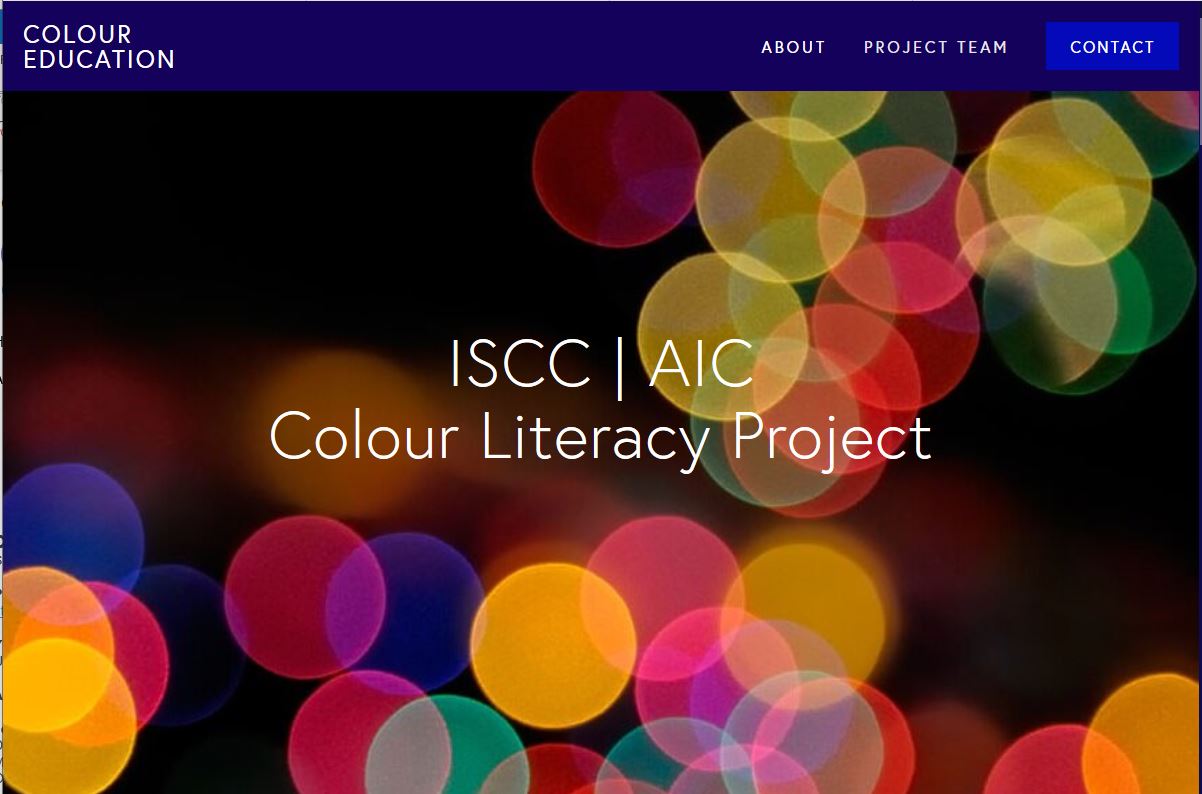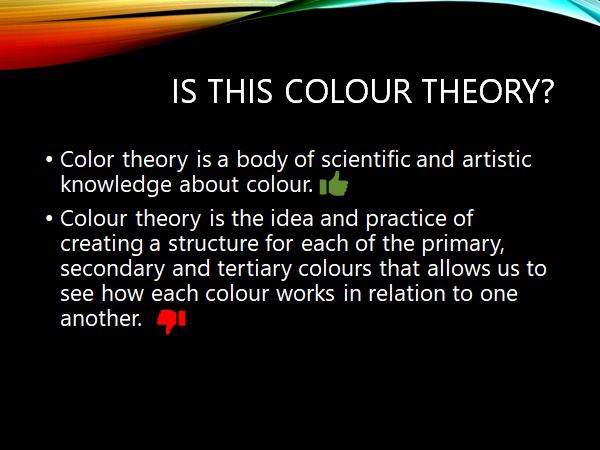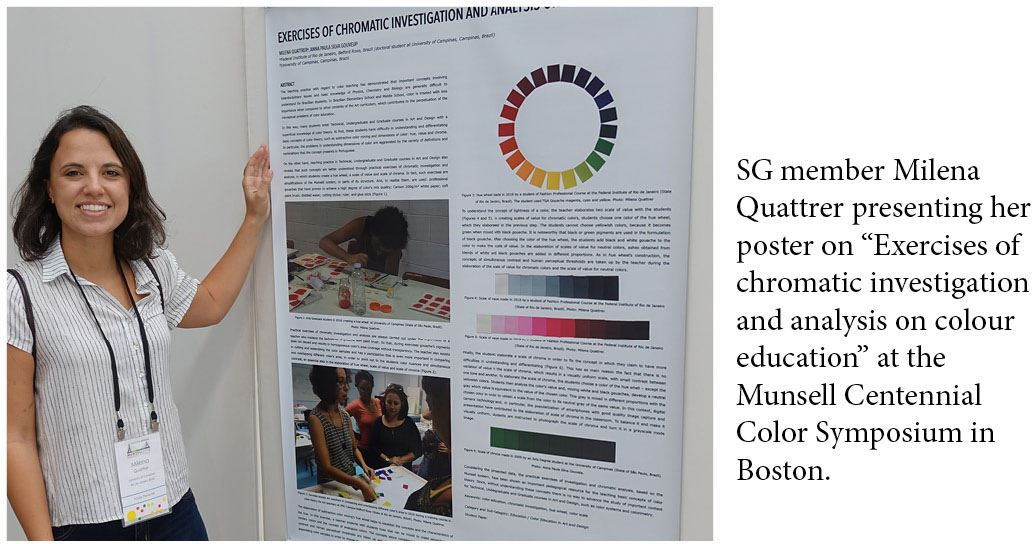COLOUR EDUCATION (CE)
Robert Hirschler | Chair
Hungary and Brazil Maggie Maggio | Co-Chair United States This study group is active since 1978. Past chairs include:
Annual Review - download recent activities of this study group |
The Colour Literacy Project is a joint project of the Inter-Society Colour Council (ISCC) of the United States and the International Colour Association (AIC). The project is managed by the AIC Study Group on Colour Education (AIC SGCE). Announcements of upcoming events and updates on the Colour Literacy Project are published in the periodic AIC SGCE virtual newsletter. If you are interested in receiving the newsletter, please click the button below to join the SGCE and be added to the mailing list. AIC STUDY GROUP ON COLOUR EDUCATION NEWS Thanks! Robert Hirschler |
PAST ACTIVITIES |
2019 Annual Review In 2019 SG Members were again very active. In this year’s report we’ll focus on a new initiative of the SG which may have significant impact on the future course our SG may take. Following the extremely successful ISCC/AIC Munsell 2018 Symposium in Boston a group of colour researchers started the ISCC/AIC Colour Literacy Project (CLP) with the purpose of identifying and addressing the most basic, current misconceptions and misinformation about colour while building a bridge between the art and science of 21st century colour education. The objective of the CLP is to develop a foundational colour education website to provide state-of-the-art, introductory, interdisciplinary information and materials on the art, science and industry of colour for use in classrooms. The project was approved by the ISCC board in August of 2019, and the AIC Executive Committee approved the Joint ISCC/AIC Colour Literacy Project in January of 2020. The first phase of the project, research on existing resources and teaching materials, concluded that the time is ripe to radically rethink basic colour education by introducing an experience-based colour learning model and recast colour as a collaborative arts and science subject at the elementary and secondary school level in STEAM programs and at the professional level across art, science, and industry. The report on the findings of the first phase, and the launch of the second phase of the project, developing and testing prototype learning modules, will take place at the ISCC Virtual Symposium: A New Vision for Colour Education on June 6, 2020. More information on the CLP will be available on a dedicated website to be launched in June of 2020.
At the last SG meeting in Buenos Aires three of the team members presented their first thoughts on colour theory, and their presentations were followed by a lively discussion. Robert Hirschler discussed the concept colour theory, what it is and whether we need it at all. Traditional colour theory is loaded with misconceptions, even the very definition of colour theory (Figure 2.) carries outdated notions, and in order to introduce 21st century colour theory we must re-think what we had learned and taught over the past centuries.
Maggie Maggio showed several illustrations of traditional colour theory (Figure 3.) and explained the pitfalls of “rehash”: theories repeated without critical review and presented as “rules” without taking developments in science and art into consideration. However, she emphasized that we must re-evaluate the foundational concepts of the traditional theory, recognize what is still valid and valuable in arts education, and not be too hasty to throw the baby out with the bathwater. Stephen Westland discussed some of the common misconceptions of primary colours according to traditional colour theory. Even the definition of “primary” colours is often wrong. Children learn already in kindergarten that “primary colours are those which cannot be mixed from other colours and from which all other colours may be mixed”. On the example of additive mixing illustrated on the CIE chromaticity diagram (Figure 4.) Stephen explained where this definition fails. | 2018 Annual Review 2018 was a busy, successful year for the SGCE. Members were active at both important AIC events of the year (Boston and Lisbon), and also in contributing to the special issue of JAIC on colour education. In the General Session of the Munsell Centennial Color Symposium in Boston we heard two great presentations on colour education by David Briggs (Where is Color Education Now? Color and Technology) and by Roy Osborne (Historical Survey of Teaching Color in Art and Design); and SGCE members presented interesting posters on this subject; many of them have since been published in Color Research and Application. At the Symposium we had an interesting panel discussion on colour education organised and moderated by Robert Hirschler, SG Chair and Maggie Maggio, SG Co-Chair with participation of a group of invited experts on the subject. The main discussion points were:
How can we work together to promote colour literacy in the 21st century? Panel discussion on colour education at the Munsell Centennial Color Symposium in Boston. Panellists (from left to right) Maggie Maggio, Mark Fairchild, Lori A. Sawaya, Paul Green-Armytage; Emily Barnett; Robert Hirschler and Luanne Stovall. Also participated in the panel discussion Harald Arnkil and Sarah Sands (unfortunately not on the picture). Also at the Boston Symposium, we had a SG meeting on the theme of “How much colour science is not too much”. After the introduction by the SG Chair, SG members Harald Arnkil, Tracy Holmes, M. Ronnier Luo, Esther Hagenlocher and Nicoline Kinch gave presentations explaining their view on the subject.
SGCE meeting at the Munsell Centennial Color Symposium in Boston. At the AIC Interim Meeting in Lisbon we had the second SG meeting of the year, the main theme being Colour Education for Children and Laypersons. The idea was that we should share thoughts on what to tell about colour to people who are not (yet) actively involved in dealing with it in some professional way. Does the average person need to know anything about colours? Is it part of the general knowledge an educated person should know? Do children need to be educated in seeing and in using colours? Paula Alessi kindly accepted to chair the meeting together with Maggie Maggio, Co-Chair of the SGCE, and we had four SG members giving presentations on the topic: Nicoline Kinch, Kelson Araujo, Natacha Le Duff and Ana Rezende Galeotti. Glenn McArthur and Osvaldo Da Pos could not be present, but they sent in their contributions in writing. The presentations were followed by a lively discussion. After the Boston meeting SG Chair Robert Hirschler was invited to guest edit a special issue of JAIC on colour education and SG members responded by submitting articles. The special issue has already been published and it is available on the AIC web site. The next SGCE meeting is planned at the AIC Midterm Meeting to be held in Buenos Aires in October 2019. |
All rights are reserved by AIC - International Colour Association |




